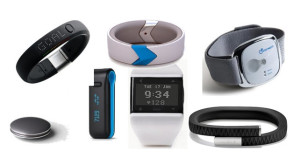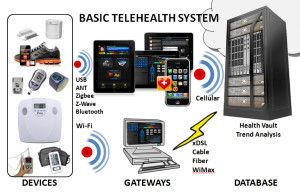Are You Ready for Some Sensors… in Healthcare?

They’re Everywhere! They’re Everywhere! Sensors that is, and it seems they sense everything too.
Here’s a tiny subset:
- Temperature (e.g. thermostat)
- Light (photocell)
- Sound & Vibration (microphone)
- Proximity (motion sensor, Doppler radar, stud finder)
- Pressure (altimeter, barometer, tire pressure)
- Magnetism (security contact switch)
- Chemicals (smoke, radon & CO2 sensors)
- Fluid Flow (water & gas meters)
- Electric Current (electric meter)
- Moisture (humidifier, leak detector, rain gauge)
- Radiation & Subatomic Particles (Geiger counter)
- Speed, Distance & Acceleration (odometer, tachometer, accelerometer)
- Pressure (barometer)
- Force (strain gauge)

Just as sensors found their way into cars and homes, they’re now being used in healthcare and going mobile. Innovative sensors are disrupting healthcare as companies find new ways to use them in devices and apps, putting the smartphone at the center a Digital Health ecosystem that’s poised to grow exponentially.
This ecosystem has already spawned many new market segments, including:
- Activity & Sleep (e.g. Basis, Fitbit, Jawbone UP, Nike+ Fuelband, UnderArmor)
- Blood Glucose (Dexcom, iBGStar)
- Blood Oxygen (Azio, Masimo, Scanadu, Tinke)
- Blood Pressure (Azio, iHealth, Scanadu, Withings)
- Body Sounds (Thinklabs digital stethoscope)
- ECG (AliveCor, Azio, Scanadu)
- EEG, Brainwaves (Emotiv)
- Hearing (CellScope)
- Heart Rate (Azio, Azumio, Cardio, Philips, Tinke, UnderArmor, Intel & SMS BioSport headphones)
- Heart Rate Variability (Azio, EmWave, iThlete, Tinke)
- Respiration (iPega iPhone Breathalyzer, Scanadu, Tinke, UnderArmor)
- Skin (Skin of Mine, SkinVision, Somaxis, SpotCheck)
- Temperature (Azio, Equivital, Scanadu, UnderArmor, Breast Cancer Screening Bra)
- Ultrasound (MobiSante)
- Urine (Scanaflo)
- Vision (EyeNetra, WelchAllyn)
- Weight (Fitbit, Fitbug, iHealth, Withings)
Is the FDA ready?
YOU may be ready for the flood of medical sensors, but is the FDA? The sheer number of digital health devices, and the pace of their introductions, is challenging the FDA’s ability to cope and to properly regulate those that have the potential for patient harm.
New types of sensors and devices occur regularly and may soon include new wearables that can “smell” and detect disease from airborne biochemical markers from our skin and breath? Recently, scientists from the University of Michigan developed a vapor sensor made of graphene material to do that monitoring continuously and noninvasive. Higher levels of acetone in diabetics, for example, may suggest low blood sugar, and nitric oxide & oxygen levels can indicate conditions such as hypertension, lung disease or anemia.
Sensors that detect potential problems before they become problematic may not need as much regulatory scrutiny as ones used in hospital settings to treat problems. Even if they have less accuracy (some have more), the benefit is continuous monitoring to detect trends and sudden changes, so over-regulation, which can slow down product development, could be worse even than no regulation. That’s the balance the FDA is trying to achieve.
Some Current Sensors
This infographic from Pathfinders Software shows just how much we can already wear these days to stay healthy.
Where do the sensors Go?
The sensors can be embedded in smartphones, wearable devices, or clothing, applied to the skin like a temporary tattoo, or even implanted under our skin. Here’s an article about an Under Skin Blood Test that sends lab results to the phone. What if sensors in the home or car or up in the Internet Cloud are used to detect potential health problems? Should the FDA regulate them too? And the network connections? In his 2010 TED Talk, Intel’s Eric Dishman shows how an old, analog, rotary-dial telephone can be used to detect Parkinson’s Disease. Surely, the FDA isn’t going to regulate the phone or phone service.
The Future (an infographic)


